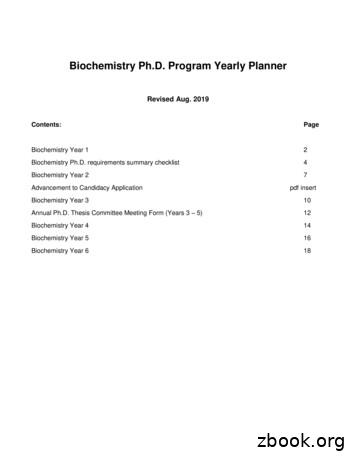Departmentof’Chemistry’&’Biochemistry’ University’of .
rsityofOregonEugene,Oregon97403USA
E0cell standard cell potential E0cell canbemeasureddirectly Inthiszinc- ‐coppercell E0cell is measured to be 1.10 V Can be calculated from standard electrode potential (E0half-cell)for each half-reaction as given in the tableE0cell E0cathode (reduction) – E0anode (oxidation)But, how do we determine E0half-cell?
Standard Reduction PotentialE values are referenced to a standardhydrogen electrode (SHE).1.0MHCl(aq) The SHE half-cell consists of a glass tube, H2gas at 1.0 atm, platinum electrode (inert, notreacting, provides a surface for the H2 gas toreact), 1.0 M HCl at 25 C.
Standard Hydrogen ElectrodeWhen coupled with a less activemetal, the SHE can serve as ananode. The oxidation half-reactionis the oxidation of H2 to 2H , thepotential difference 0.0 VoltsH2(g, 1 atm) 2 H (aq, 1M) 2e-E 0.0 Voltsanoxida2onreac2on
Best ox agent
hRps://www.google.com/search?biw 1146&bih 835&tbm isch&sa 1&ei - ‐NVLWu KEMqS0gKy74PwDA&q Zinc Standard Hydrogen Electrode electrochemical cell diagram&oq Zinc Standard Hydrogen Electrode electrochemical cell diagram&gs l psy- 2.3297.29j7.36.0.0.1c.1.64.psy- ‐ab.3.0.0.0.jb22KMCv9zs#imgrc X7CrnyG XG2I M:
urfaceofthepla2numelectrode2.Writethehalf- ode.
Standard Reduction PotentialsAnodehalf- ‐reac2on:Cathodehalf- ‐reac2on:Overallcellreac2on:H2(g)2H (aq) 2e- ‐E 0.0VCu2 (aq) 2e- ‐Cu(s)E ?VH2(g) Cu2 (aq)2H (aq) Cu(s)E hestandardhalf- thecathodeandtheoxida2onattheanode: Ered (cathode)- ‐Ered (anode)Ecell 0.34V XCu2 /Cu–{0.0V}SHEThemeasuredpoten2alforthiscell:E cell 0.34V
E cell is a Potential DifferenceBetween Two Half-CellsThe greater the differencebetween the two half-cellreactions, the greater thevoltage of the cell. 0.40V 0.34V0.00Cu2 (aq) 2e- ‐H2(g)Cu(s)2H (aq) 2e- ‐
urfaceofthepla2numelectrode2.Writethehalf- de4.Writethehalf- .
om/watch?v CQ7gYg64Msc
Standard Hydrogen ElectrodeWe select as a standard halfreaction the reduction of 2H toH2 under standard conditions,which we assign a potentialdifference 0.0 VoltsTheSHEcanserveasacathode.2 H (aq, 1M) 2e- H2(g, 1 atm) E 0.0 Voltsareduc2onreac2on
urfaceofthepla2numelectrode2.Writethehalf- ode.
How to Calculate a StandardReduction PotentialAnodehalf- ‐reac2on:Zn(s)Cathodehalf- ‐reac2on:2H (aq) 2e- ‐Overallcellreac2on:Zn2 (aq) 2e- ‐Zn(s) 2H (aq)H2(g)E ?VE 0.0VZn2 (aq) H2(g)E 0.76V Ered (cathode)- ‐Ered (anode)Ecell 0.76V 0.0V(SHE)- ‐{x}Zn/Zn2 X - ‐0.76VZn(s)Zn2 (aq) 2e- ‐Zn2 (aq) 2e- ‐Zn(s)E - ‐0.76VE 0.76Voxida2onAsastandardreduc2onpoten2al
E cell is a Potential DifferenceBetween Two Half-CellsThe greater the differencebetween the two half-cellreactions, the greater thevoltage of the cell.0.00VH2(g)2H (aq) 2e- ‐- ‐0.50V- ‐0.76VZn2 (aq) 2e- ‐Zn(s)
Determinetheiden2tyofthemetal.E cell 2.37V
The SHE half-cell consists of a glass tube, H 2 gas at 1.0 atm, platinum electrode (inert, not reacting, provides a surface for the H 2 gas to react), 1.0 M HCl at 25 C. 1.0’M HCl(aq) E valu
Chemistry ORU CH 210 Organic Chemistry I CHE 211 1,3 Chemistry OSU-OKC CH 210 Organic Chemistry I CHEM 2055 1,3,5 Chemistry OU CH 210 Organic Chemistry I CHEM 3064 1 Chemistry RCC CH 210 Organic Chemistry I CHEM 2115 1,3,5 Chemistry RSC CH 210 Organic Chemistry I CHEM 2103 1,3 Chemistry RSC CH 210 Organic Chemistry I CHEM 2112 1,3
4. Plant Biochemistry 5. Clinical Biochemistry 6. Biomembranes & Cell Signaling 7. Bioenergetics 8. Research Planning & Report Writing (Eng-IV) 9. Nutritional Biochemistry 10. Bioinformatics 11. Industrial Biochemistry 12. Biotechnology 13. Immunology 14. Current Trends in Biochemistry
1. Fundamentals of Biochemistry by J.L. Jain 2. Biotechnology by B.D., Singh 3. Principles of Biochemistry by Lehninger, Nelson & Cox 4. Outlines of Biochemistry by Conn & Stumpf 5. Textbook of biochemistry by A VSS, Ramarao 6. An Introduction to Practical Biochemistry by D.T. Plummer 7. Laboratory Manual in Biochemistry by Jairaman
Chemistry is the science that describes matter, its properties, the changes it undergoes, and the energy changes that accompany those processes. Inorganic chemistry Organic chemistry Physical chemistry Biochemistry Applied Chemistry: Analytical chemistry, Pharmaceutical Chemistry, . Istv an Szalai (E otv os University) Lecture 1 6 / 45
BSc MSci Biochemistry and Biological Chemistry Accredited by the Royal Society of Chemistry, these courses equip you with the fundamental aspects of biochemistry and chemistry. Teaching is split between the School of Life Sciences and the School of Chemistry, providing you with expertise from both subjects. Year one
Physical chemistry: Equilibria Physical chemistry: Reaction kinetics Inorganic chemistry: The Periodic Table: chemical periodicity Inorganic chemistry: Group 2 Inorganic chemistry: Group 17 Inorganic chemistry: An introduction to the chemistry of transition elements Inorganic chemistry: Nitrogen and sulfur Organic chemistry: Introductory topics
Advancement to Candidacy Application pdf insert Biochemistry Year 3 10 Annual Ph.D. Thesis Committee Meeting Form (Years 3 – 5) 12 Biochemistry Year 4 14 Biochemistry Year 5 16 Biochemistry Year 6 18
Analytical Biochemistry (Textbook) Analytical Biochemistry, 2nd edition, by D.J. Holme and H. Peck, Longman, 1993 Available on Reserve. Physical Biochemistry (Textbook) Physical Biochemistry (2nd edition, 1982) D. Freifelder (QH 345.F72). This is a particularly good reference text for spectroscopy, centrifugation, electrophoresis, and other .























